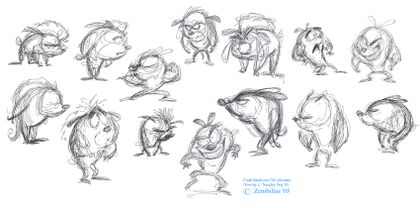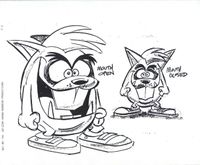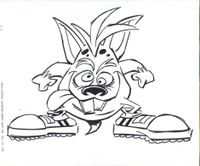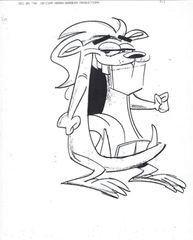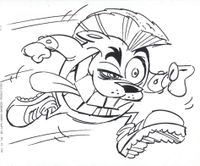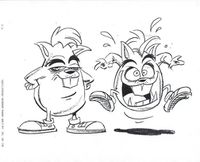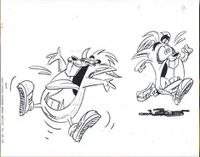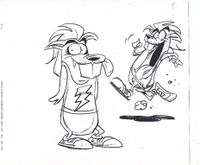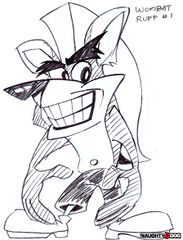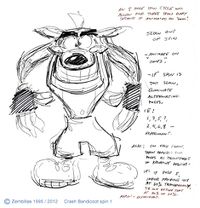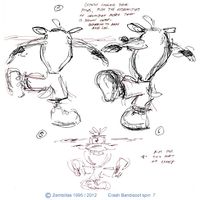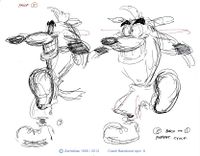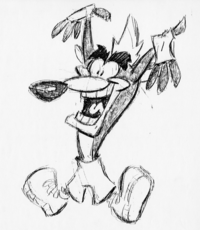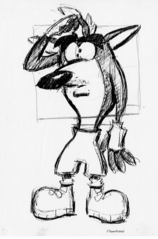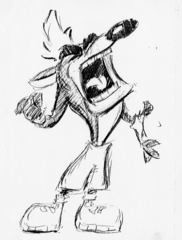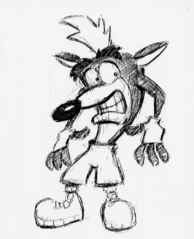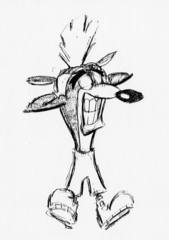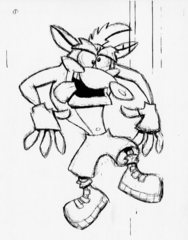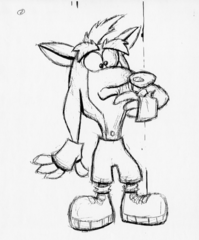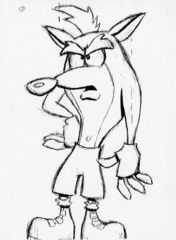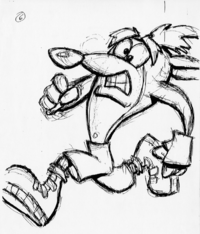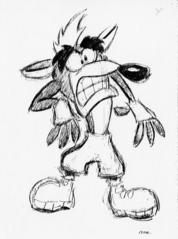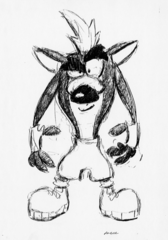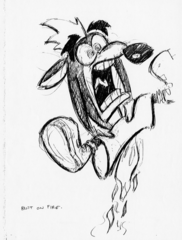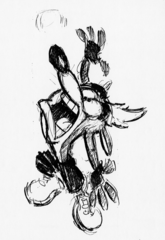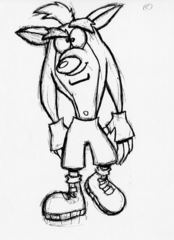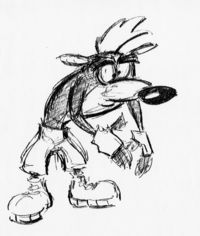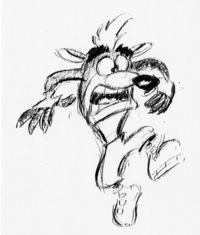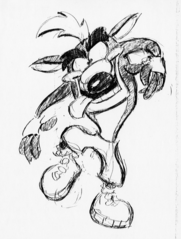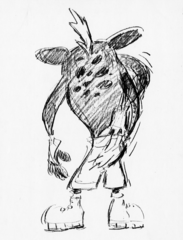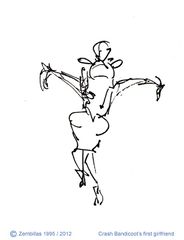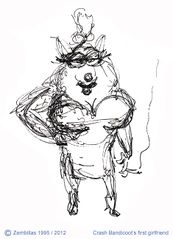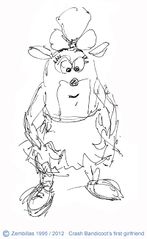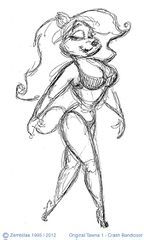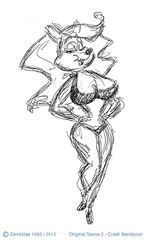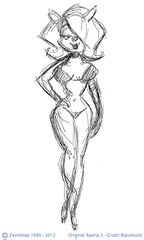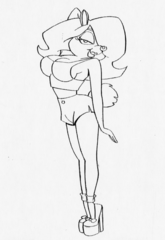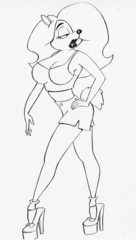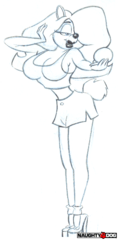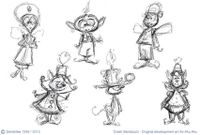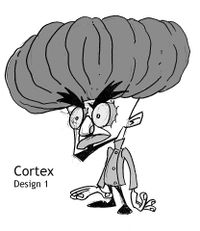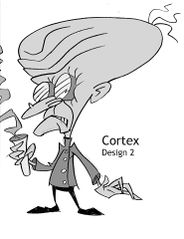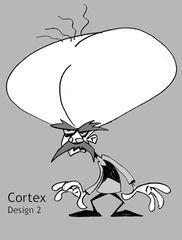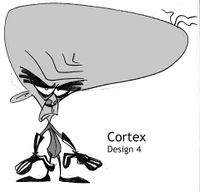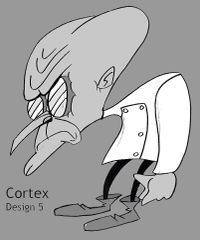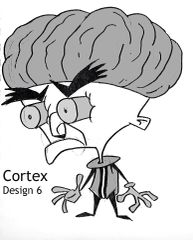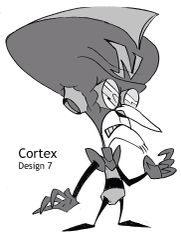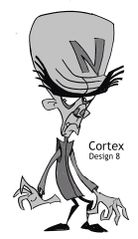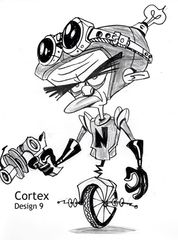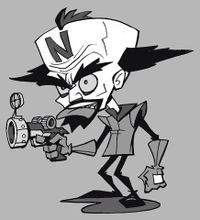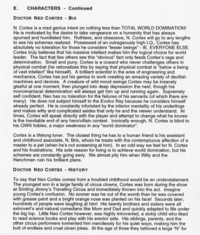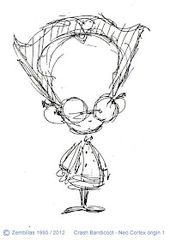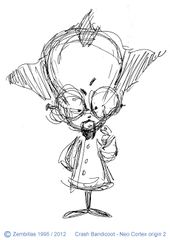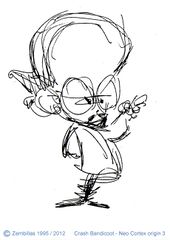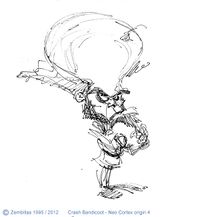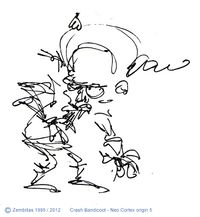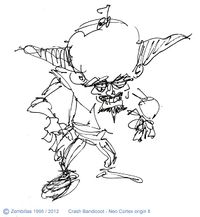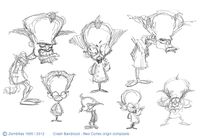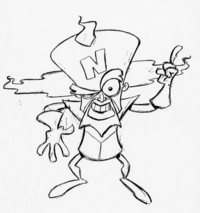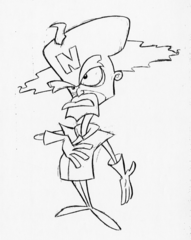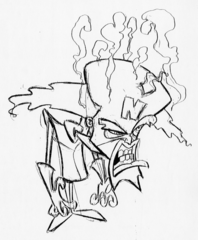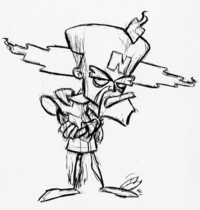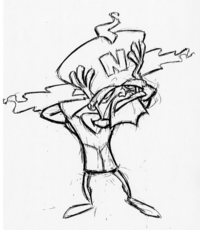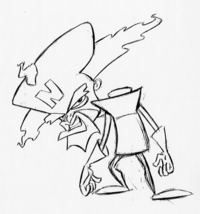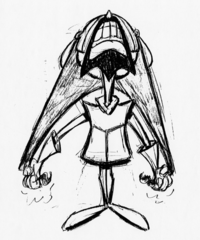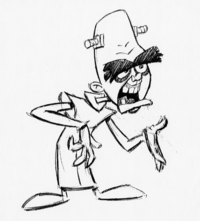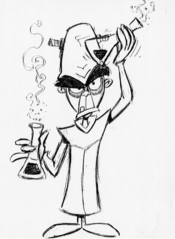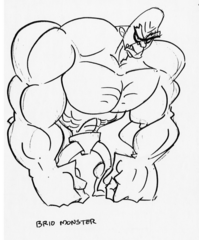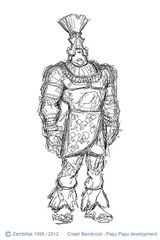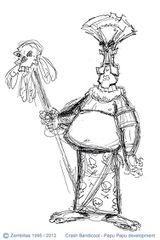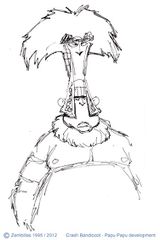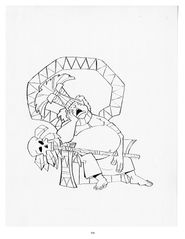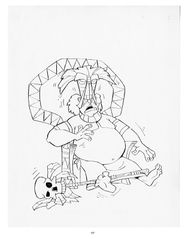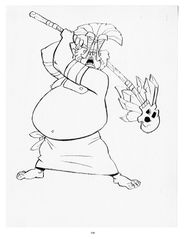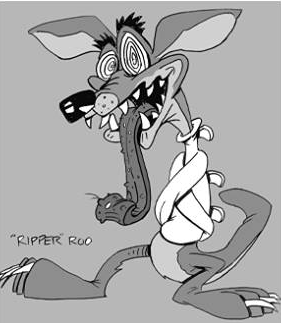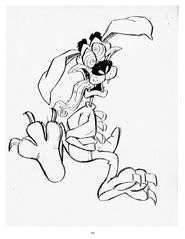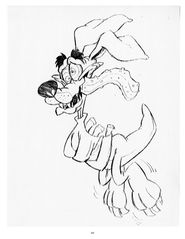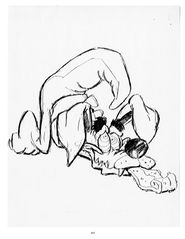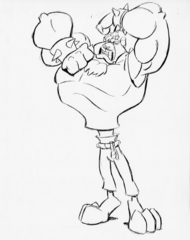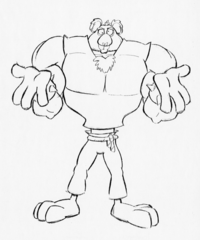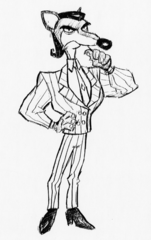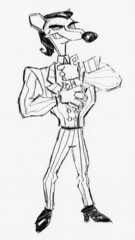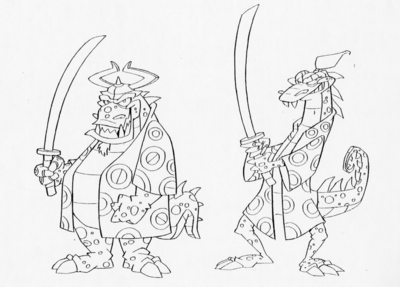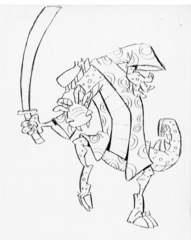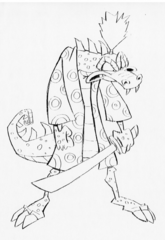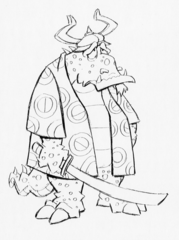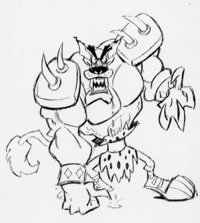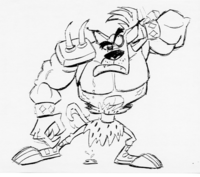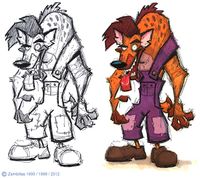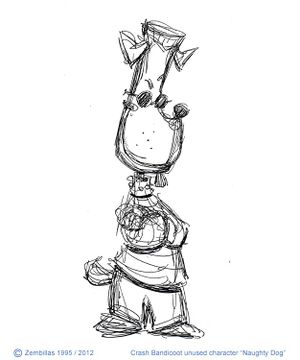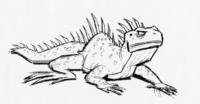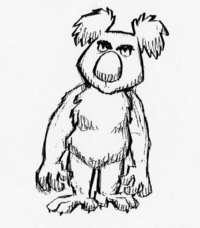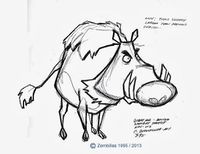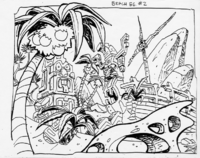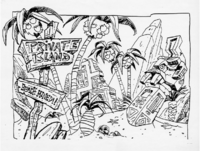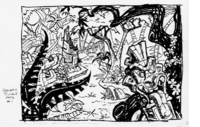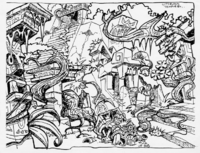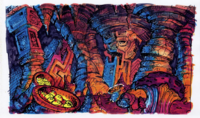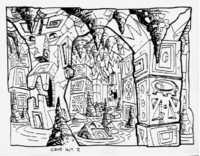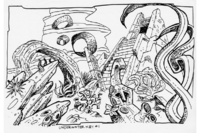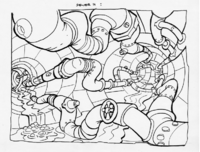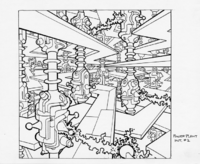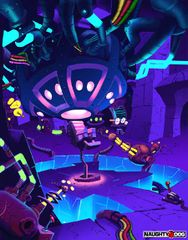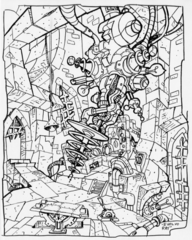Prerelease:Crash Bandicoot/Concept Art
This is a sub-page of Prerelease:Crash Bandicoot.
Contents
Characters
Crash
One of the main reasons Naughty Dog chose to develop Crash Bandicoot for the PlayStation was Sony's lack of an existing mascot character that could compete with Sega's Sonic the Hedgehog and Nintendo's Mario.[1] By this time video game mascots were seen as increasingly unimportant, since they were overshadowed by cross-licensing and the aging games market meant most gamers were too old to find mascots appealing but Sony were nonetheless interested in covering all bases.
For the game's lead character, Naughty Dog wanted to do what Sega and Warner Bros. did while designing their respective characters – Sonic the Hedgehog and the Tasmanian Devil – and incorporate an animal that was "cute, real, and no one really knew about". The team purchased a field guide on Tasmanian mammals and selected the wombat, potoroo and bandicoot as options. Naughty Dog founders Andy Gavin and Jason Rubin went with "Willy the Wombat" as a temporary name for the starring character of the game. The name was never meant to be final due both to the name sounding "too dorky" and to the existence of a game with the same name. The character was effectively a bandicoot by October 1994 but was still referred to as "Willy the Wombat" since a final name had not been decided yet.[1] Wanting their mascot game to be multi-dimensional in character depth as well as gameplay, Gavin and Rubin chose not to base Willy around one attribute such as "fast" or "cute". The team felt that Willy should be "goofy and fun-loving, and never talk". The character's muteness was based on the theory that voices for video game characters were always "lame, negative, and distracted from identification with them."[1]
In March 1995, Universal Interactive and Naughty Dog recruited Joe Pearson of Epoch Ink to aid in the visual aspect of production. Pearson in turn recommended Charles Zembillas of American Exitus to be brought on board and the two met with Naughty Dog weekly to design the characters and the environments of the game.
"I was doing more of a squat, hunkered-down character. I was just trying different things, you know? I was just trying different things and going in different directions. Joe made him kind of longer and leaner and goofy. I was trying to make him look a little more manic and insane. We kind of blended those two together. [We] went with what Joe was doing stylistically and I took that kind of crazy, nutty thing that was happening and I blended it into what Joe was doing."
— Charles Zembillas[2]
It was decided early on that there would be no connection between a real animal and Willy's final design which would instead be determined "51% by technical and visual necessity and 49% by inspiration". Gavin determined Willy's fur color by creating a list of popular characters and their colors, and then making a list of earthly background possibilities (such as forests, deserts, beaches, etc.). Colors that would not look good on the screen were strictly outlawed, such as red, which would bleed on older televisions. Orange was selected by process of elimination. Willy's head was made large and neckless to counter the low resolution of the screen and allow his facial expressions to be discernible. Rubin noted the increased difficulty in turning Willy's head with this type of design. Small details such as gloves, spots on his back and a light-colored chest were added to help the player determine what side of Willy was visible based on color. Willy was not given a tail or any flappy straps of clothing due to the PlayStation's inability to properly display such pixels without flickering. The length of Willy's pants was shortened to keep his ankles from flickering as they would with longer pants Andy Gavin owns the original ink sketches of Willy by Charles Zembillas.[1]
Crash's design went through a number of changes throughout development. In a YouTube video posted in July 2018, animator Butch Hartman revealed that he was one of numerous artists contacted in 1994 to create his own designs for Crash's prototype, Willy, during his time at Hanna-Barbera. This version had a small, round body, though elements of inspiration of Crash's final self could already be seen.[3]
Joe also created a production bible called The Crash Bandicoot Files, which included detailed backstories of Crash and the rest of the cast. According to the bible, Crash would communicate in a series of bizarre non sequiturs derived from pop culture as a result of his subjection to the Cortex Vortex. One of Crash's early concept designs by Pearson depicts him wearing a black mask, making him resemble Zorro. Regardless, this is never referenced in the final game.
According to Andy Gavin, Naughty Dog wanted Crash to animate similarly to the old Looney Tunes cartoons with squash-and-stretch physics. This was achieved with "vertex animation", which allowed infinite points of articulation as opposed the more common and stiffer "skeletal animation," which could only use a limited amount.
"In those days, most people used a simple skeleton system with “1 joint” weighting, and very few bones. This gives a very stiff look, so we went instead with vertex animation. This allowed us to use the more sophisticated 3-4 joint weighting available in PowerAnimator, which the Playstation had no hope of matching at runtime (until the PS2), instead we stored the location of every vertex, every frame at 30 frames a second. No one else had the guts, as while this was easy to render, it required inventing some totally hardcore assembly language vertex compressors. First me (three times), then Dave (twice), then finally Mark took a crack at it. Mark’s was the best — being the best assembly programmer of us three — but also the most complicated."
— Andy Gavin.[4]
Crash's jumping, spinning and bonking mechanisms were refined as the team developed the levels "Heavy Machinery" and "Generator Room".
While preparing for the game's demonstration at the 1996 E3, the team decided to finally rename Willy into "Crash Bandicoot" (the particular name being credited to Dave Baggett and Taylor Kurosaki) with his surname being based on his canonical species and his first name stemming from the character's tendency of breaking boxes. The names "Dash", "Smash" and "Bash" were also considered. The marketing director of Universal Interactive Studios insisted that the game and character should be named "Wez", "Wezzy" or "Wuzzle Wombat" but the name Crash Bandicoot prevailed in the end after Naughty Dog threatened to leave the production.[5] As a result, the character Pinstripe's name and species was changed (along with his goons) from bandicoot to potoroo though no design changes were further made.
The following sketches were designed by Charles Zembillas, dated around 1995.
Tawna
Tawna was created by Joe Pearson and Charles Zembillas, as were most of the other characters in the game. Unlike most of these, however, Tawna was created to be a supporting character for Crash Bandicoot, specifically being Crash's love interest; to this effect, the May 5th 1995 edition of the production bible describes her as "window dressing". Similarly to how Crash Bandicoot was formerly called "Willy the Wombat", Tawna was also a wombat named Karmen (also spelled Carmen). Both she and Crash were named as bandicoots for the final release of the game.
Charles Zembillas' first sketches of Tawna, allegedly made on January 1995, depict Tawna with a body type more similar to early concepts of Crash. Potential characterizations for her ranged from "the girl next door to street walker to dimwitted floozy to plain jane". A more anthropomorphic design would eventually be decided on for Tawna, focusing on conventionally attractive features. Her original finalized design would appear on the May and August 1995 editions of the game's production bible, only to be altered afterwards in order to be less provocative.
"This image of Tawna was later scaled back for...politically now...aesthetic reasons. The original idea: Pamela Anderson with a brain. Cool, huh? We thought so, too."
— Naughty Dog[6]
The earliest mention of Tawna being a damsel-in-distress for Crash to rescue can be seen in a document detailing the script of an opening sequence for the first game dated February 20th 1995, written by Joe Pearson. Originally, Karmen was created by Neo Cortex to be Willy's romantic partner, for the purpose of creating a line of "Uberwombats". Cortex would later decide to have Karmen for himself after banishing Willy from his army and castle. Karmen opposed Cortex's advances and intent of war, instead only wishing to be with Willy. This same story would also appear on the May 1995 edition of the production bible, though Karmen's character description was inelaborate, particularly compared to other characters. Her defining traits included frequently touching up her make-up, loving to shop, and hating being in Cortex's laboratory.
The August 15, 1995 edition of the production bible revises the opening sequence pitched in the February and May 1995 editions of the document. It officially renames Karmen to Tawna, and recharacterizes her to be more assertive and intelligent. In the script, she openly defies Cortex, remarking on his army's failures. This edition also features a more elaborate description of Tawna's intended character and role in the story, calling her "the perfect blend of beauty and brains". She was written to match wits with Cortex, attempt to reason with N. Brio who at that point was a more sympathetic character and try to get Cortex's henchmen to rebel against him. Naughty Dog's official website for Crash Bandicoot also echoes this description of Tawna.
The April 8th, 1996 prototype of Crash Bandicoot is the earliest publicly-available record of Tawna having her final, scaled-back design. Tawna's color scheme in this prototype is drastically different, however; her fur and muzzle colors are an orange-ish brown both as opposed to separately-colored orange fur and peach muzzle, her shirt and socks are magenta instead of burgundy, her shorts are green instead of blue, and her eyeshadow is blue instead of a pale rose color. Tawna still retained this design in the May 11th, 1996 prototype. The prototype coloration was also used for a series of test animations produced by Universal Animation Studios for Crash Bandicoot, though both were rejected by Sony Computer Entertainment and disincluded out of preference for 3D animation. This coloration of Tawna can be seen in the final game on a banner in The Great Hall, although with the pale rose eyeshadow of the final design. Tawna herself sports the older colors when the curtain is pulled back, before Crash reaches her, but is shown with her final coloration in the ending cutscene.
In the end, most of the traits that Tawna is described with in the August 1995 edition of the bible didn't make it into the final game. Particularly, both Crash and Tawna's lines were cut from the intro and replaced with a dialogue between Neo Cortex and N. Brio. Tawna is instead shown to be restrained by two lab assistants.
The following sketches were designed by Charles Zembillas, dated 1995.
Aku Aku
Aku Aku was created by Joe Pearson and Charles Zembillas as the protector of Crash Bandicoot. Originally he was concepted as fairy or a genie as seen in the early concepts made by Charles. However, these concepts were scrapped and Aku Aku was later depicted as a human witch doctor who wore a wooden mask with six feathers above the head, pupil-less eyes, thick lips and a leaf goatee. Eventually, his final design was decided to be a sentient wooden mask. The August 1995 edition of the bible added that he could communicate through mumbles only intelligible to Crash, in a manner similar to the dynamic between C-3PO and R2-D2 from Star Wars.
The following sketches are dated around early 1995.
Dr. Neo Cortex
During the development of Crash Bandicoot, Naughty Dog founders Andy Gavin and Jason Rubin conceived the idea of Cortex while eating near Universal Interactive Studios. Gavin came up with the idea of an "evil genius villain with a big head" who was "all about his attitude and his minions". Rubin, having become fond of the animated television series Pinky and the Brain, imagined a more malevolent version of the Brain with minions resembling the weasel characters in Who Framed Roger Rabbit. After Gavin put on a voice depicting the attitude in mind for the character, he and Rubin instantly came up with the name "Doctor Neo Cortex". Gavin and Rubin described Cortex to character artists Joe Pearson and Charles Zembillas as "[having] a huge head but a tiny body, he's a mad scientist, and he dresses a bit like a Nazi from The Jetsons". [1]
Pearson did the initial sketches of Dr. Cortex as he did with the majority of the characters for the game. Once a design was approved, Charles would take over and make them in multiple poses and attitudes.
Here you can see the evolution of Cortex's early designs by Joe Pearson:
"For Cortex, the brief from Naughty Dog was to design a classic evil scientist/brainiac. This is hard to beat as great subject matter for an artist. Villains in many ways are more fun and certainly easier to design than heros.
[...]So I did these initial 10 designs. I'm sure 3 or 4 would have been plenty, but I was having a lot fun. I'm pretty happy with the group of them. They have a lot of variety and in the end, any one of them could have made a strong Cortex.
The consensus at Naughty Dog was that they wanted to see a combination of two of the designs, a fusion of number 1 and number 10, keeping the lower face and beard of number 1, but putting it on the head and eyes of number 10 and the general costume and body of number 10."
— Joe Pearson[7]
Joe Pearson also wrote a full character profile for Cortex, included in the 1995 edition of the production bible detailing his backstory and personality. The bible details Cortex's birth to a large family of circus performers, the abuse he suffered from being made part of the family act (which culminated in a large "N", standing for "nerd", being tattooed onto his forehead), the murder of his family in a fireworks explosion and a period of vagrancy and fugitivity with his henchman and high school classmate Nitrus Brio. No major changes of his character profile were made in the August 1995 edition.
Dr. Cortex was originally envisioned as a self-aware video game character who was bothered by the clichés he embodied and addressed the audience throughout the game. This aspect was removed however after Naughty Dog decided that cutscenes would disrupt the game's pacing. In the final product, because his game model was unable to walk properly due to the short length of his legs, he was kept stationary since he was absent throughout the game most of the time.
"Cortex had few of these issues. We could make him totally improbable, un-animatable, and just keep him bigger on the screen. He didn’t show up too often anyway. He could never really walk with those short legs. He had to do a weird thrusting tra-la-la dance. But he looked cool so we just kept him stationary most of the time."
— Jason Rubin[1]
The following sketches were designed by Charles Zembillas, dated 1995.
N. Brio
The earliest known artwork of Nitrus Brio, produced by Charles Zembillas, was first made in January of 1995. By this point, his design was essentially finalized to what would appear in the final game. Other concept art included in the production bible depicts N. Brio without bolts in his head; though undated, it suggests earlier work was done. A number of concepts for N. Brio's monster form were done as well. Potential design elements included spiky claw and club arms, a cobra body, tentacles, a metal chest plate, and neck spines. Eventually, the simpler muscular form seen in the final game was decided on.
A draft of the game's production bible in the February 1995 edition, established N. Brio's history and early personality. N. Brio was designed to be a foil to Cortex with their dynamic being compared to that of Spock and Captain Kirk of Star Trek.
"Dr. N. Brio is a foil for Dr. Cortex. Meek to Cortex's strength, Logical to Cortex's emotional, successful (his inventions work) to Cortex's failure."
— Naughty Dog[6]
While Cortex was obstinate and emotional, N. Brio would be calm and logical, to the point of seeming emotionless. He was worshipfully devoted to Cortex, who treated him with contemptuous affection in return. Though N. Brio attempted to be a "voice of reason" to Cortex, he was frequently ignored and would take the blame when their plans went awry. As a result, he would voluntarily tighten the bolts in his head as self-punishment. N. Brio would also use the Evolvo-Ray on himself in an attempt to increase his own intelligence but instead he'd devolve into the vicious "Brio-Monster".
A later edition of the bible dated May 5th 1995, added that Cortex and N. Brio left a trail of destruction wherever they traveled, arriving on the islands while fleeing from the law. No further changes were made to N. Brio's character or history until August 15, 1995. In this version, Cortex installed the bolts in N. Brio's skull, which he would tighten to punish him. Instead of using the Evolvo-Ray to transform himself, N. Brio would drink a mutagen he'd designed to replace both the Evolvo-Ray and Cortex Vortex.
In the final game, N. Brio remained as Cortex's right hand man. Despite his dynamic with Cortex being evident in their dialogue, their history together was not mentioned in the game.
The following sketches are from the production bible, dated 1995.
Papu Papu
Early concept designs of Papu Papu depicted him as a tall, muscular warrior. However, Naughty Dog wanted a fat character because they thought it would be fun to animate someone with jiggly motions. In the August 15th, 1995 edition of the production bible, his character bio describes him as a great warrior during his youth who became lazy as he grew older. Interestingly, it mentions that Aku Aku was still a witch doctor during that time suggesting that his future design hadn't been thought of yet.
The following sketches were designed by Charles Zembillas, dated 1995.
Ripper Roo
Ripper Roo was designed to demonstrate the dangers of Cortex Vortex exposure in a humorous manner as well as the implementation of animation techniques such as overlapping action. In an early script for the game's opening sequence, Ripper Roo was named as one of Neo Cortex's many animal henchmen, and would appear briefly in the scene. Later drafts of the game's bible would revise this script but keep Ripper Roo's role the same.
The May 5th, 1995 edition of the production bible included information of Ripper Roo's personality and history. The bible mentions that he would entertain himself by making shadow puppets and he would occasionally howl his name. An abridged version of his story was included in the August 1995 edition with some minor changes such as shortening his claw length from six feet to twelve inches. All these details however never made it to the final game.
The following sketches are from the production bible, dated 1995.
Koala Kong
Concept work for Koala Kong began with three initial concept designs drawn on an unknown date by Joe Pearson, each with varying features. However, the core traits — a koala character with a round silhouette, sleeveless arms, no neck, and a scowling expression — were decided early on. Pearson also produced one of the earliest drafts of the game's production bible on February 20, 1995, which included a script for the opening sequence of the game. At that point, the character was named Koala Khan. His final design was mostly on par to what is seen in the finished product with the exception of having spiked wrist bracelets. His spiked bracelets were not present in-game, though they were added in Crash Bandicoot N. Sane Trilogy, which includes a remake of the game.
The May 1995 edition of the production bible made no major changes to the original opening sequence script, and thus it still called the character Koala Khan. This edition also added information on Kong's history and personality. Apparently, he had adapted a persona by watching films like Rocky during his treatment and, although he lacked intellect, he would compensate it with his strength and endurance. In addition, he was eventually renamed as Koala Kong by that point. The August 1995 edition made some changes to his story while keeping his overall personality the same.
Koala Kong was originally planned to be the second of two bosses on the first island, fought on top of a giant tree.[8] In the final release of Crash Bandicoot, Kong's boss fight was moved to the end of the second island inside a cave.
The following sketches are from the production bible, dated 1995.
Pinstripe Potoroo
Pinstripe was originally envisioned as a bandicoot (nicknamed Pinstriped Bandicoot) but was renamed as a potoroo later in development. This likely was related with Naughty Dog's decision to rename the game's protagonist, previously known as Willy Wombat to Crash Bandicoot. The earliest known mention of him was in the February 20, 1995 edition of the game's production bible simply called Pinstripe in which he briefly appeared in Cortex's castle along with the other mutants in a script for the game's opening sequence.
Besides the pinstripe pattern on his suit, his design remained unchanged in the final game. In the May 5th, 1995 edition of the production bible, his character brief states that his boss fight was to be in the middle of a planned minecart section of the game.[9] An undated list of levels also included in The Crash Bandicoot Files places him after a power plant area on the game's third island instead, which was retained in the final game.
A full character profile was included in the August 15th, 1995 edition of the production bible describing Pinstripe's brief history as Cortex's loyal servant and his relationship with other mutants such as Koala Kong and the Dragon Brothers. Although his position as CEO of Cortex Power & Gas Co. and protector of Neo Cortex are referenced in the game and its manual, his interactions with Koala Kong and the Dragon Brothers were not.
The following sketches are from the production bible, dated 1995.
Komodo Brothers
Concept creation of the Komodo Brothers began during early preproduction. Originally designed by co-creator Joe Pearson, the brothers' character designs were radically different compared to the final versions seen in their debut in Crash Bandicoot 2: Cortex Strikes Back. Their first design depicts them being dressed up like samurais with katanas and spotted, loose-fitting robes. During early preproduction, they were not yet named at this stage, nor did the collective name "Komodo Brothers" exist. The prototype Komodo Joe was a smaller lizard than his brother, with dark scales, two large fangs, a bald head, and a scaly spine running down the back of his neck. The prototype Komodo Moe was stocky with a sharp-toothed underbite and a goatee. He sported a small spiked helmet with two bent horns on either side, resembling a kabuto (samurai helmet). Both brothers had spotted skin.
Later on, concept artist Charles Zembillas produced new art of the duo for the May 5th 1995 edition. Though an earlier draft of the bible from February had named the brothers Kimono and Kimodo, the May edition was the first to specify which brother was which. Kimono was the brother most analogous to the modern Komodo Joe, while Kimodo was analogous to Komodo Moe. The new concept art touched up Kimono's design, making him slightly taller than Kimodo, with a longer nose and hair tied in the style of a Thai topknot. These would be their final designs until their concepts were revisited during production of Cortex Strikes Back.
The May 1995 edition of the production bible added information about the brothers' personalities and history. At that point in time, they were called the Dragon Brothers and both shared a proficiency with katanas and ruthless personalities due to watching Asian films and thus being influenced by samurai culture and martial arts. The August 1995 draft of the bible abridged the Komodo Brothers' profiles while also adding new information. Most notably, though, their names were swapped: the brutish, stronger brother was renamed Kimono, while the scrawnier, more conniving one was named Kimodo.
The Komodo Brothers were absent in the final game due to the lack of time and the fact that the game had already too many bosses. Their fight would take place at the end of the Ruins.[10]Although they were intended to be fought together, composer Josh Mancell produced a demo song attributed to a planned Komodo Joe boss fight. It was not included on the disc of the game as Naughty Dog determined early on that they would not have time to implement the fight.[11]
The following sketches are from the production bible, dated 1995.
Tiny Tiger
During development, Tiny's name was originally "Tazmanian Tiger" or simply "Taz Tiger". The production bible describes Tiny as a killing machine, noting that his bloodthirsty nature is attributed to brutal footage shown to him in the Cortex Vortex combined with an increased treatment period. In the May 1995 edition of the bible, his character brief states his boss fight was planned after a snowboarding segment.[12] Tiny Tiger along with the Komodo Brothers were the only bosses that were omitted and later re-imagined for the sequel.
The following sketches are from the production bible, dated 1995.
Additional Mutants
According to Zembillas, there were additional characters that were planned but never used. These anthropomorphic mutants were supposed to have distinct personalities. Naughty Dog however, decided to change them to simple animals instead.
"Naughty Dog"
At some point during the Willy Wombat days, Zembillas created a character with the same name as Naughty Dog as a courtesy to the company. Not much is known about him other than he would appear as a cameo in the game along with the rest of the cast.
Other
Sketch of a scrapped crocodile enemy (This was later used in Warped)
Environments
References
- ↑ 1.0 1.1 1.2 1.3 1.4 1.5 Making Crash Bandicoot - part 2
- ↑ Polygon
- ↑ How I Helped Create Crash Bandicoot| Butch Hartman
- ↑ Making Crash Bandicoot - part 3
- ↑ Making Crash Bandicoot - part 6
- ↑ 6.0 6.1 Making Of Crash Art
- ↑ Crash Mania - Artwork/Joe Pearson
- ↑ The Crash Bandicoot Files: How Willy the Wombat Sparked Marsupial Mania, p. 165. "Is waiting for you at the top of the tree. Defeating him allows access to the cavern entrance."
- ↑ The Crash Bandicoot Files: How Willy the Wombat Sparked Marsupial Mania, p. 178. "After completing the first section of the cavern cart section, this enemy awaits. Defeat him and then challenge the next section of minecart fun."
- ↑ The Crash Bandicoot Files: How Willy the Wombat Sparked Marsupial Mania, p. 170. "These characters are located at the end of the Ruins area, and must be defeated before proceeding to the next island."
- ↑ Crash Bandicoot-Interviews "R" us.
- ↑ The Crash Bandicoot Files: How Willy the Wombat Sparked Marsupial Mania, p. 182. "After snowboarding along the snow caps, this enemy is waiting for you at the Half Pipe. Defeating him will allow entrance to the sewer."

